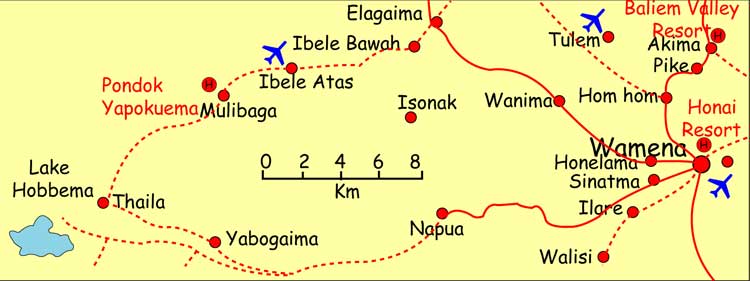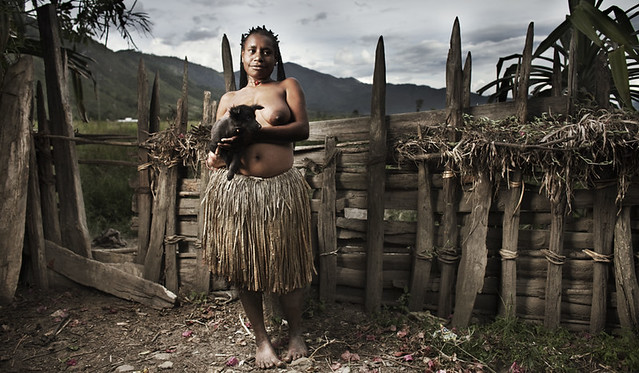IR
13C NMR
RAMAN
MASS
1H NMR
1-Bromo-3-phenylpropane
| |||||||||||||||||||||
Peak Table
1H spectrumThis spectrum, like all other simple 1H spectra, can be assigned by using the following criteria;
1H spectrum (expansion) | |||||||||||||||||||||
Notes
| |||||||||||||||||||||
TAKE A TOUR
Baliem Valley
Baliem Valley - Wikipedia, the free encyclopedia
en.wikipedia.org/wiki/Baliem_Valley
The Baliem Valley, also spelled Balim Valley and sometimes known as the Grand Valley, of the highlands of Western New Guinea, is occupied by the Dani ...
 wamena airport
wamena airport
Baliem Valley Trekking Expedition to the Most Primitives Tribes of Indonesia
Baliem Valley and the Dani tribe waited a long time to be discovered. Papuan highland belongs to one the most recently explored New Guinea areas. The tall mountains in west Papua (Irian Jaya) were generally considered as uninhabited. No sooner than 1398 did the pilot Richard Archbold notice that there was something special about the deep, and large valley situated among the four-thousand meter tall mountains. In the valley there were clearly recognizable fields, similar to those he knew from Europe. The Baliem valley and Dani tribe were discovered by pure luck.

The Baliem Highlands is centered on the Grand Valley some 1,600 meters above sea level. Temperatures of the highland are ranged from 26 degrees Celsius at the day time and 12 degrees at night.. The valley is 60 kilometers long and 15 kilometers wide and is surrounded on all sides by mountain peaks rising to between 2,500 and 3,000 meters.This valley has been the most visited part of the island, especially in recent years. This valley is home to the Dani tibesmen. They are living in primitive way of farming.
Baliem Valley, is a spectacular valley which an ideal location for our innovative trek that follows trails through the jungle and mountain environs of the Dani, Yali and Lani People. Until a generation ago these stone-age tribes had little to do with the outside world, until the arrival of white missionaries in the 1950s (a fact well documented in Heinrich Harrer’s account of the first ascent of Carstensz Pyramid in 1962). Even today, the Dani’s reliance on stone axes and on an agricultural lifestyle – that evolves around raising pigs and growing root crops – provides a fitting insight into their tribal traditions.
This spectacular valley is an ideal location for our innovative trek that follows trails through the jungle and mountain environs of the DANI PEOPLE. Even today, the Dani’s reliance on stone axes and on an agricultural lifestyle – that evolves around raising pigs and growing root crops – provides a fitting insight into their tribal traditions.

The proposed program of we attached here allows you to experience some trekking to deeper side of Dani’s communities at the southern part of the magnificent valley, to encounter people who are living in so-called STONE AGE as they are almost naked people, as well as to experience their ancient way of live.
The trekking it self is considered moderate to challenging grade as we will trek up and down the hills, cross rivers and thru its slippery banks.
Baliem Valley, inhabited by the Dani tribe, is the most fertile part of the highland covering the west of the New Guinea Island – Papua (Irian Jaya). Baliem Valley lies about 1600 m above the sea level, and it is surrounded by a crest of mountains some of which reach up to 4500 m. There are even some fish in the Baliem River which flows through the valley. The area covered by the Baliem valley is not large, roughly 60×30 km.
The first missionary, Loyd van Stone, parachuted there as late as 1954. Only then did the civilization of the Baliem valley, and Dani and Lani tribes, begin. Since then, the Baliem valley has become a gate for discovering the west of the Papua highland. No road has been built there yet, but in Wamana a large airport was built, and supplies are now transported by large freight airplanes. Despite all these developments, the Baliem valley is still dominated by the straw roofs of the Dani tribe. Danis are an indigenous tribe, which dwelled in the Baliem valley in the time of its discovery. Danis belong to some the “most decorative” tribes in the west Papua
You have probably seen the famous photos of Dani tribe members with boar tusks in their noses, and headdresses made of Paradise birds feathers. Dani men only wear long and thin kotekas. The women Danis wear short skirts woven from orchid fibers, decorated with straw, and with indispensable woven bags called “noken” across their backs. Similar to the women of the Yali tribe, the Dani women wear short skirts below their butts.
Despite the fact that Danis were discovered quite late – in 1938, they became one of the best known tribes in New Guinea. Dani occupied one of the most fertile parts of Papua. As a result they often had to fight for their territory. There were also frequent wars among the Danis themselves. They were the most dreaded head-hunting tribe on the island, which is even more remarkable if we consider that they did not eat their enemies, like the majority of other Papuan tribes did.
With us you can be in a face to face contact with Dani people. Dani build round or oval huts, and their villages are enclosed by fences. They are farmers, and their small fields are distinctly bordered. This is what helped Richard Archbold spot them from the plane. The Dani tribe’s customs and culture are very rich and interesting. Several pages could be written on these topics
The main reason that the Dani tribe is so well known, is that the Baliem valley where they live, is relatively easy to reach these days.
The main reason that the Dani tribe is so well known, is that the Baliem valley where they live, is relatively easy to reach these days.
Wamena was a point of departure for many expeditions. The Dani villages are visited by virtually every tourist who sets out in west Papua. Some villages even show their original customs and hold mock wars.
Another thing which brought fame to the Dani tribe are the several hundred years old ”smoked” mummies of famous tribesmen. Two of them can be seen in the Baliem valley – in Akima and Jiwika villages.
The Baliem Valley was once dubbed Shangri La and it is easy to see why. The Valley is incredibly lush and fertile and is surrounded on all sides by towering peaks of 2,500to 3,000 metres.
The fertility is such that the valley has been farmed for 9,000 years but it was only discovered by westerners in 1938! There are three mains tribes inhabiting the Baliem Valley: The Dani in the base, the Lani to the west and the Yali in the south-east. Each tribe has a distinct culture. One sure and interesting way to distinguish between the tribes is from the Koteka, or penis gourd, sported by the male members. The men of each tribe tend to the growing of the gourds with the three tribes each cultivating a different style. The Dani use a long, thin Koteka, the Lani sport a medium sized, wide cannon-like gourd, and the Yali wear the longest of all.
The Baliem Valley was once dubbed Shangri La and it is easy to see why. The Valley is incredibly lush and fertile and is surrounded on all sides by towering peaks of 2,500to 3,000 metres.
The fertility is such that the valley has been farmed for 9,000 years but it was only discovered by westerners in 1938! There are three mains tribes inhabiting the Baliem Valley: The Dani in the base, the Lani to the west and the Yali in the south-east. Each tribe has a distinct culture. One sure and interesting way to distinguish between the tribes is from the Koteka, or penis gourd, sported by the male members. The men of each tribe tend to the growing of the gourds with the three tribes each cultivating a different style. The Dani use a long, thin Koteka, the Lani sport a medium sized, wide cannon-like gourd, and the Yali wear the longest of all.
The Dani
Entering Dani territory involves a journey into a deeper reality.
The inevitable pig-feast on arrival is your rite of passage into their unique culture for an engrossing a four or five hour intense experience. You will find yourself in a simple, traditional compound surrounded by fully greased and painted Dani tribes-people wearing their ceremonial best.
Entering Dani territory involves a journey into a deeper reality.
The inevitable pig-feast on arrival is your rite of passage into their unique culture for an engrossing a four or five hour intense experience. You will find yourself in a simple, traditional compound surrounded by fully greased and painted Dani tribes-people wearing their ceremonial best.
The whole elaborate affair is deeply spiritual, far more than a photo-session can ever capture. Here you will be warmly greeted by the amazing Chief Yali, our adoptive father who is legendary amongst the Dani for his kindness, generosity and skills in the art of co-operation and avoiding conflict. With this unique and privileged connection you will receive the full weight of Dani hospitality.
The Lani
Like the Dani, the Lani are expert farmers utilising a highly effective and efficient irrigation system to produce abundant crops of Sweet Potatoes (Ubi), Tobacco, Beans, Taro, Spinach, Sugar Cane and Bananas. Much of the Lani lands lie in a beautiful oasis interspersed with checkerboard patterned sweet potato gardens. The Lani are more stockily built than the medium-bodied Dani and their lands are more densely populated. They tend to congregate in largish villages rather than the small compounds which dominate Dani territory.
Like the Dani, the Lani are expert farmers utilising a highly effective and efficient irrigation system to produce abundant crops of Sweet Potatoes (Ubi), Tobacco, Beans, Taro, Spinach, Sugar Cane and Bananas. Much of the Lani lands lie in a beautiful oasis interspersed with checkerboard patterned sweet potato gardens. The Lani are more stockily built than the medium-bodied Dani and their lands are more densely populated. They tend to congregate in largish villages rather than the small compounds which dominate Dani territory.
The weather in the Valley is predominantly sunny and trekking along the river amidst the terraced farmlands and wondrous forests is a trekker’s paradise. Trails are usually clear and maintained as local people travel them and this makes the trekking pretty comfortable.
The Yali
The Yali tribe lives high up along the valley ridges in the Jayawijaya mountains. The land here is rugged and thinly populated. The tribes-people live in wooden huts with roofs made of tree-bark and they are grouped into small compounds. A vegetable garden and dense rainforest will surround each compound.
The Yali tribe lives high up along the valley ridges in the Jayawijaya mountains. The land here is rugged and thinly populated. The tribes-people live in wooden huts with roofs made of tree-bark and they are grouped into small compounds. A vegetable garden and dense rainforest will surround each compound.
Trekking in the Yali area is more strenuous than in the lower reaches of the Valley but it is perfect for the fit trekker who wants to experience truly virgin rainforest and the unique people who live amidst it.
In summary, The Baliem Valley will provide a never to be forgotten experience. The inhabitants of the valley are essentially peace-loving agrarians who welcome visitors wholeheartedly.
In summary, The Baliem Valley will provide a never to be forgotten experience. The inhabitants of the valley are essentially peace-loving agrarians who welcome visitors wholeheartedly.
 .
.

 On the streets of Wamena - Wamena, Papua
On the streets of Wamena - Wamena, Papua
////////












Best Mobile Services
ReplyDeleteAs a Phenoxypropanol supplier, I can state that the information you've provided in your articles has been quite beneficial to my understanding.
ReplyDelete